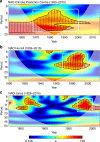Inter-annual and decadal changes in teleconnections drive continental-scale synchronization of tree reproduction
- PMID: 29263383
- PMCID: PMC5738406
- DOI: 10.1038/s41467-017-02348-9
Inter-annual and decadal changes in teleconnections drive continental-scale synchronization of tree reproduction
Abstract
Climate teleconnections drive highly variable and synchronous seed production (masting) over large scales. Disentangling the effect of high-frequency (inter-annual variation) from low-frequency (decadal trends) components of climate oscillations will improve our understanding of masting as an ecosystem process. Using century-long observations on masting (the MASTREE database) and data on the Northern Atlantic Oscillation (NAO), we show that in the last 60 years both high-frequency summer and spring NAO, and low-frequency winter NAO components are highly correlated to continent-wide masting in European beech and Norway spruce. Relationships are weaker (non-stationary) in the early twentieth century. This finding improves our understanding on how climate variation affects large-scale synchronization of tree masting. Moreover, it supports the connection between proximate and ultimate causes of masting: indeed, large-scale features of atmospheric circulation coherently drive cues and resources for masting, as well as its evolutionary drivers, such as pollination efficiency, abundance of seed dispersers, and natural disturbance regimes.
Conflict of interest statement
The authors declare no competing financial interests.
Figures




References
-
- Ashton PS, Givnish TJ, Appanah S. Staggered flowering in the Dipterocarpaceae: new insights into floral induction and the evolution of mast fruiting in the seasonal tropics. Am. Nat. 1988;132:44–66. doi: 10.1086/284837. - DOI

